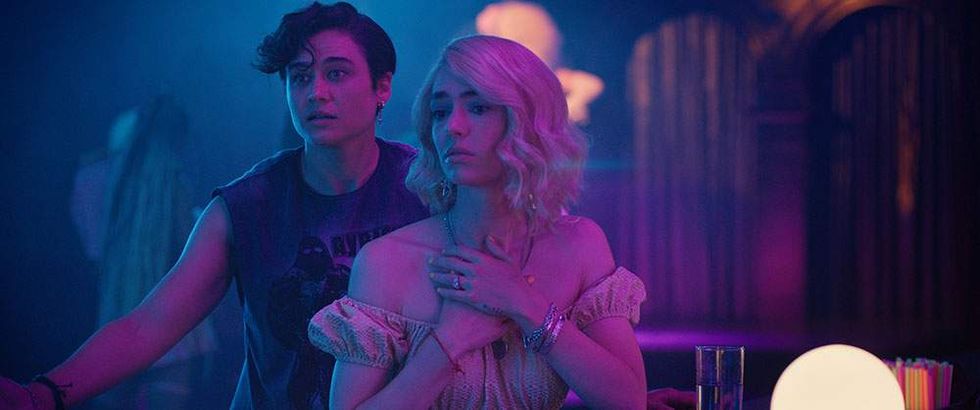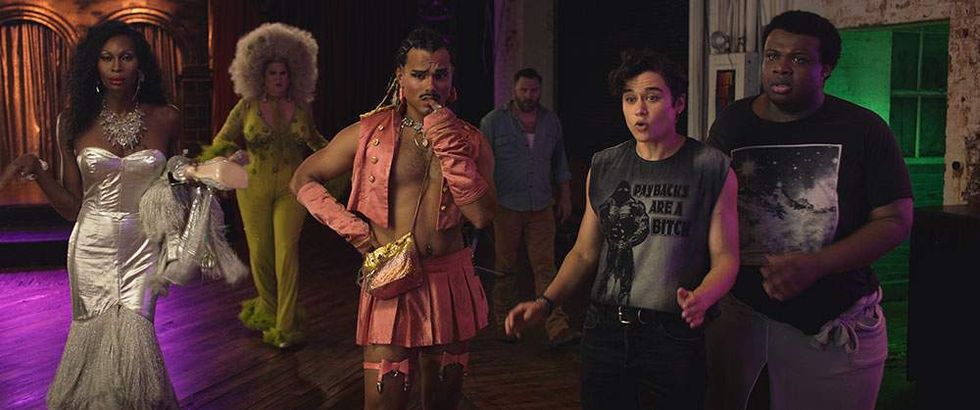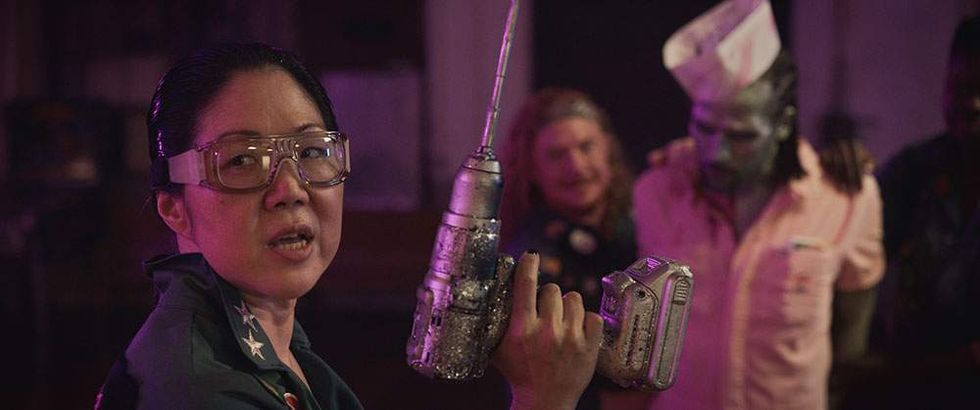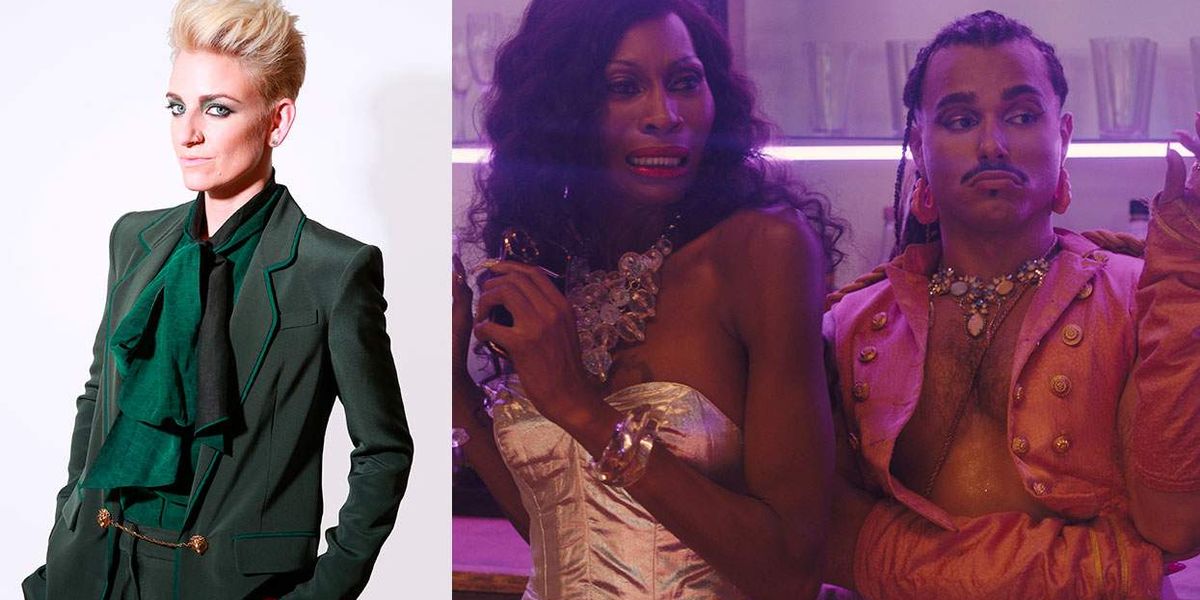In the world of horror cinema, Romero is a highly revered surname that’s become synonymous with the zombie genre and a legacy of influential classics such as Night of the Living Dead and Dawn of the Dead. Just ask Tina Romero, the daughter of the legendary George A. Romero, the trailblazing auteur who singlehandedly created the blueprint for the modern-day zombie film and ignited a new genre that would inspire and endure for decades to come.
Now, Tina is ready to follow in her late father’s footsteps, and she’s well aware of the level of expectation her last name brings. Not only that, but she’s tackling a subject that’s become a family heirloom. Her feature-length directorial debut, Queens of the Dead, is an outrageous comedy-horror flick about a group of drag queens, club kids, and frenemies who are trapped inside a Brooklyn warehouse party that’s surrounded by bloodthirsty zombies. But Tina isn’t merely replicating her father’s doom-and-gloom formula; she wants to put her own stamp on the genre and inject some ingredients of her own, such as glamorous camp, glittery gore, and, of course, a gleeful dose of queerness. To put it frankly, it’s unlike any movie her father has ever done.
Queens of the Dead’s colorful characters — which are mostly queer aside from a token straight dude — are played by an equally eclectic cast of predominantly LGBTQ talent such as Katy O’Brian, Margaret Cho, Cheyenne Jackson, Jack Haven, Nina West, and Dominique Jackson, just to name a few. And the result is: It’s an unabashedly queer zombie romp (not to mention, an endearing love letter to George) that’s destined to become a gay camp classic that’ll surely be on your watchlist every Halloween season.
During an exclusive interview with Out, Tina opens up about the pressure that comes with carrying the zombie torch and what it was like growing up surrounded by such horror royalty. She also shares touching memories about bonding with her late father, how he reacted to her queer Queens of the Dead pitch, and what witchy Romero classic she’d love to remake.

Out: Not everyone can say they have a horror director legend like George A. Romero as a father. You must have so many stories and memories of getting to visit the sets of his films or meeting other horror icons while growing up.
Tina Romero: I tell people I sat on a zombie’s lap before I met a mall Santa. I learned to walk on the set of Day of the Dead. I actually just had a screening at Beyond Fest in L.A., and Adrienne Barbeau came to see the film. She was in several of my father’s films, and she’s a beloved person to me. And she just reminded me how I was a really colicky baby and how my mom could never get me to stop crying, but I would stop crying for her. These collaborators of my father’s, they were like our extended family. They were the people who came over to our house on holidays. Yes, they are horror icons, but to me, they were like aunts and uncles.
What are the fondest memories you have of your father?
My dad made some really dark and freaky shit, but he was such a gentle giant. He was so silly, so playful. He loved West Side Story. We watched movies together all the time; it was our primary form of bonding, and he showed me how OK it was to be moved by movies. He would just weep unabashedly at the opening notes of the West Side Story overture. And he really showed me the power of how films can move people. He was the best. And I miss him terribly.
The last name Romero is synonymous with horror royalty and zombies in particular. When you first decided to make Queens of the Dead, were you ever a little hesitant to do a zombie movie as your debut because of the pressure and expectation that comes with the name?
Absolutely. These are incredibly big shoes to fill. And I didn’t want to touch zombies unless I could do it in a way that was authentic to me and a story that I could really tell. So when the idea hit me to use queer nightlife as my vessel, it was very clear. I knew that this was the way I could carry the torch. And I’m just so psyched to, because we’re in this time when the gays are so under attack and feeling scared of everything, I’m so happy that I can take this legacy and put a queer stamp on it. It feels extra important to me. I’m also very proud that this is not a movie he would make. It’s not a George Romero movie, but I hope that people feel his spirit. I really do, because his spirit is in me. And I wanted to make a movie that played in his sandbox and by his rules, but had my own stamp on it.
You definitely added your unique stamp: There’s the camp, the glamour, and the glittery gore. What were the most important rules from his zombie universe that you for sure felt had to be ingredients in your movie?
Number one: slow zombies. Number two: one shot to the brain kills them. Number three: one bite turns you. And most importantly: writer Aaron Judge and I felt it was so important for us to say some shit — to get the social commentary in there. So we had our monster. We knew our rules. We added one, which is that [these zombies are] still responding to their devices, which is a rule I think he would approve of. And what are the social issues we want to dig into? Opioid epidemic, phone addiction, infighting within the community, and too much information in a crisis. And then from there, it was all about the characters. I feel like his films really were about the people at the end of the day, surviving in this crazy apocalypse situation. So it really came down to telling authentic stories about people that my co-writer and I know, about a world that we knew.

I’m glad you mentioned the cell phone thing. It was very parallel to what your father did with Dawn of the Dead and his statement on consumerism. These days, people are like zombies with their phones. I think you nailed that perfectly. But I also got some Day of the Dead vibes. Your father invented the smart zombie with Bub. Music plays a big role in your movie and the zombies seem to recognize it and they recognize the club. It reminded me of that Day of the Dead scene with Bub with the headphones on.
Yes! I’m so psyched you’re drawing that parallel. We were thinking about that scene in Dawn of the Dead, when they’re looking over the balcony, “Oh, this was an important place to them.” We wanted to channel the zombies queuing up outside the club. This was an important place to them. And that drib and drab of human behavior that zombies still remember, like picking up our devices. I feel like that will be us in the afterlife. We are so chained to this crazy device. In our lifetimes, we’ve seen ourselves go from not having them to just being totally attached to them. It’s just crazy to me. I don’t know if you caught the homage to the Day of the Dead score in my film, but we actually had Blitz Berlin sample John Harrison’s “The Dead Suite.” It’s one of my favorite Easter eggs in the movie. And the character of Jax, the go-go dancer who overdoses and then resurrects, and they throw them in the go-go cage. That scene between Jax and Nico is calling back to the scene in Dawn of the Dead when there’s just the pane of glass between the zombie and they’re looking at each other because I think there’s something so powerful about the zombie as a monster and how it is just a mirror of ourselves, so I wanted to channel that. I really was thinking about Dawn of the Dead a lot in the writing and in the directing. In fact, I had Samora la Perdida study Bub. She asked me what her homework was and I said, “Go watch Day of the Dead’ and watch Bub, and that’s what I’m going for.”
Effects legend Tom Savini, who played a crucial role in a lot of your father’s films, has a cameo. Did Tom offer any guidance when it came to your gore elements or practical effects?
I was so excited about the idea of putting legends from the Romero universe. Tom actually wasn’t on set. We did that over Zoom. Low-budget filmmaking, baby. But he was crucial. He was such a mentor to me in all the years of prep. This movie is eight, nine years in the making, and every time I found myself in Pittsburgh, I would go over to his office and we would just chat and shoot the shit about the gore. And he totally was on board for my desire to get glitter in the blood. And so we had a lot of conversations about how to organically do that. When you’re brainstorming is one thing, but when you’re on set in reality, having to pull it off is a totally different thing. But Tom was absolutely a guiding force. And at the end of the day, when we were struggling, he and his team designed that zombie baby. They made that for me. Because we were like, “Do we use a real baby?” And I just thought, “No, that’ll be a disaster.” And I called Tom and I said, “Tom, please, can you help me?”
You have such an eclectic cast of some powerhouse LGBTQ+ actors and comedians in Queens of the Dead. And you have funny people like Margaret Cho in the mix, so this must’ve been a blast to shoot. I bet there are so many bloopers and outtakes. This is your first feature-length film, so how flexible were you with letting all these big personalities go crazy with ad libs or improv?
What a dream cast! I’m still pinching myself. They are all incredible, they’re professionals, they came to work, they were not afraid to get dirty. And I was so nervous. I was like, “Am I going to show up on set and have this room full of icons staring at me, and my mind’s going to go blank?” But it was the complete opposite. It was a total joy to work with them. They made it so comfortable to play, and we had a lot to do. This was an ambitious shoot. We did not have a lot of time, and there was a lot of dialogue — it’s a dialogue-heavy film. Me and Tom Wills, my genius Steadicam operator, thank goodness for them, because they were willing to wear the Steadicam the whole time, which is a feat to be on Steadicam in the dead of summer. But once we got our scene, we were able to leave room for improv takes. And I would just let them go until I had to call cut, because they were hilarious. One of my favorite Easter eggs when Nico goes, “They’re coming to get you, Barbara.” That was a total improv moment and I love it so much.
This project has been in the making for nine years and I know you have said that you once mentioned the Queens of the Dead idea to your dad when he was alive. What was his reaction to finding out that you wanted to make an LGBTQ+ zombie movie? And was there any valuable advice he gave you?
My dad’s number-one piece of advice was always, “Just do it, kid.” When I came out to him, he was happy. He was like, “Men are assholes. That’s great.” I’m so lucky that he was so accepting of me. In fact, when I asked Margaret Cho to do the role, I wrote her a letter saying that, when I came out to my dad, he, within the next year, booked us tickets to go see her on tour in Pittsburgh. And, in the moment, I felt that that was his way of being like, “I accept you,” because she was very out as bisexual and her comedy act was a little risqué. And I felt like that was him sort of saying, “Look, it’s OK. It’s cool. I’m down.” And he got the concept [of Queens of the Dead]. He was all about it. He just said, “Do it. Whatever it takes, do it.” I mean, he struggled to get movies off the ground. He knows how hard it is, but he also was like, “Don’t let anything get in your way. Just get it done.” And it took a long time, but we did it.

Your father’s zombie movies were standalone and often had bleak endings: you never really saw returning main characters. But some of your queens live to fight another day. It kind of represents the gay community and how we fight and make it through these struggles, whether it’s civil rights movements or an epidemic, at the end of the day, we band together and we fight through it. Do you see yourself continuing a story with the survivors of Queens of the Dead?
Hell yeah. I’m obsessed with these characters. I can’t wait to play with them some more. I want to keep going with these characters. I do think that it’s important to let a little time pass because I think that’s crucial to films. I think his films are so special because they’re like these time capsules. There were a lot of years between them. And I think because of that, he was able to say something fresh and new about the times. And so I wouldn’t want to force something too soon. I would like to let a couple of years pass so that we can say something interesting and fresh with whatever comes next. Because that’s what’s most important about the Romero universe.
Do you ever see yourself remaking one of your father’s movies? If so, which one do you think jumps out as worthy of a modern-day retelling?
That’s such a cool question. There’s only one film of his that I would ever want to touch. And that is Hungry Wives, a.k.a. Season of the Witch. And the reason I say that is because it’s the only film he would have wanted to remake. And I think it’s a really interesting story that could use some more resources and an updated perspective. I love witches. And I think that hobbyist witchcraft is kind of a thing right now. So I’d like to explore what happens when a disgruntled housewife takes up witchcraft and things start happening.
Queens of the Dead opens in theaters on October 24.

